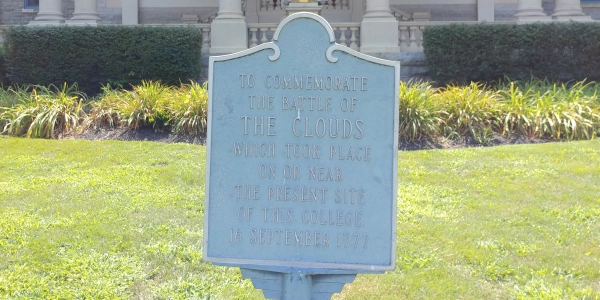
Image above: Drawing of the British capture of the forward batteries on the location of Fort Oswego in the May 6, 1814 Battle of Fort Oswego in the War of 1812, 1814, Captain R.M. Steele. Courtesy Library of Congress.
Spotlight on Lesser Known History
Forts of Oswego/Fort Ontario
America's Best History Spotlight
On this page we're going to Spotlight the lesser known historic sites and attractions that dot the history landscape across the USA and are worth a visit if you're in their area. And while they may be lesser known, some are very unique, and will be that rare find. You'll be, at times, on the ground floor, or maybe even know something others don't. It'll be fun. Visit them.

Oswego Forts, New York
There were three forts in Oswego, New York built to defend the area by the British. The original Fort Oswego on the western side of the Oswego River, Fort George, an outer work of Fort Oswego also on the western side, and Fort Ontario, on the east. Only one is still there as a magnificent New York State Historic Site, and that is Fort Ontario. Fort Oswego has a couple plaques on a downtown street, a bit meager considering its importance, but alas, at least they've got some. Fort George has two interpretive signs in Montcalm City Park. In 1756, the French attacked all three forts in a land attack and bombardment. Fort Ontario was the only one rebuilt by the British in 1759, although the site of Fort Oswego was used for shore batteries thereafter. Thus, you'll get a great chance to see just what all three of these forts were about at Fort Ontario, even if you'll have to use more imagination with the others. Image above: Fort Ontario and lighthouse, 1900, Detroit Publishing Co. Courtesy Library of Congress.
Sponsor this page for $100 per year. Your banner or text ad can fill the space above.
Click here to Sponsor the page and how to reserve your ad.
Info, What's There Now, History Nearby
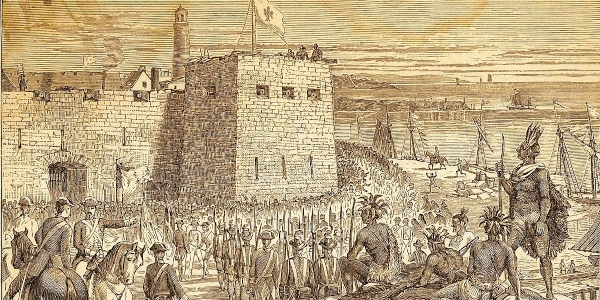
Oswego Forts, New York
The three forts were built to protect British interests along the contested area of Lake Ontario and western New York. Fort George was still being constructed in 1756, Fort Oswego had been constructed in 1729, and Fort Ontario in 1755. During the French and Indian War Battle of Oswego, the French and their allies, attacking from Lake Ontario and overland, captured all three forts, one thousand seven hundred soldiers and civilians, one hundred artillery pieces, and seven ships. It would give the French control of Lake Ontario for nearly three years. In 1759, the British returned and rebuilt Fort Ontario, then abandoned it during the American Revolution. The United States destroyed it then. The British returned and rebuilt again, occupying it until 1796. It would later be expanded and used by the U.S. Army in a variety of capacities until transferred to New York State to eventually become a historic site in 1949. The other two forts were never rebuilt.
Today, Fort Ontario State Historic Site is open to visitors. It is a star-shaped fort, about the fourth incarnation on site, that dates back to the 1840's. There are guardhouses, barracks, exhibits and so much to tour, expect to spend most of the day there. And you'll get all that French and Indian, American Revolution, War of 1812, Civil War, and more history along the way as well.
Image above: Battle of Fort Oswego in 1756, 1877, John Henry Walker, Tuttle's Illustrated History of the Dominion. Courtesy Wikipedia Commons via the Journal of Montreal. Below: Winter at Fort Ontario, 2018, Danno74. Courtesy Wikipedia Commons C.C. 4.0.
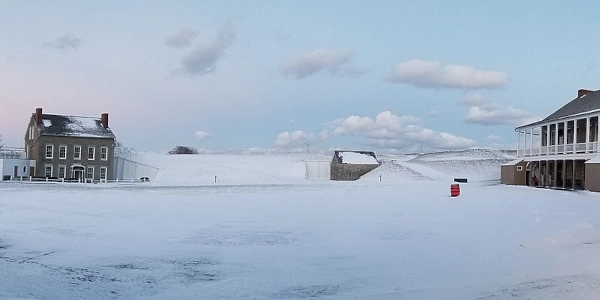
Where Is It
Fort Ontario, which is your main stopping off place is located at 1 East Fourth Street, Oswego, NY 13126. If you wish to see the other signs and Montcalm City Park that are associated with Fort Oswego and Fort George, best to ask at the Visitor's Center at Fort Ontario. Oswego, New York is in northeast New York, eastern side of Lake Ontario. It is forty miles north of Syracuse.
What is There Now
Forts of Oswego
Fort Ontario State Historic Site is a wonderful place to visit which takes you back in time to the defense of the British colonies, the United States, and for a bit, the French. A walk around the star-fort will take you through tunnels of powder magazines, cannon bastions, barracks, and a whole lot more. There a picnic tables, guided tours, and on certain days of the year, re-enactments.
As for Fort Oswego, as stated below, there are only two historical markers on the western side of Oswego. For Fort George, there is not much more, however, they are located in Montcalm City Park. It'll be like going on a scavenger hunt.
When Open and How Much
The historic site is open from early May through Columbus Day from Wednesday to Sunday. It is open on Monday holidays. Cost is $4 adults, $3 seniors/children, children 12 and under free.
Fees subject to change.
Websites
Fort Ontario State Historic Site
History Nearby
It's eastern upstate New York and there's a plethora of forts to visit, as well as Niagara Falls, a bit far away, and if you're coming up from the south, a Baseball Hall of Fame.
Buy Chronology

Great Book for the History Fan with Fifty Short Essays Telling the Story of American History.
Photos, History, and More Spotlights

Fort Oswego
Originally built as a trading post in 1722, and later fortified as a blockhouse in 1729 after the French built Fort Niagara, it was known as Fort Burnet. In 1741, it was fortified with stone walls and bastions, known as Fort Pepperell for a short time before taking on the Fort Oswego name. Once the French and Indian War #4 began, it was fortified even further, and included an army of one thousand seven hundred British regular and colonial troops under General William Shirley.
Fort Oswego was the strongest of the three forts at the time, but subject to attack from the eastern side of the Oswego River. Once French General the Marquis de Montcalm brought his three thousand soldiers and Indian allies to bear on Fort Ontario from Lake Ontario on August 13, 1856, capturing it quickly, he trained his guns on Fort Oswego and Fort George the next day. They surrendered.
The British would return to the grounds in 1758, but not rebuild. In the War of 1812, the Fort Oswego site was used as a supply and transit point for American troops along the Great Lakes. It had only five cannons and two hundred and forty-two men of the 2nd U.S. Artillery guarding the area plus an equal amount of militia and sailors. That strength was not enough to ward off a direct attack from the British.
When the attack came in May 6, 1814, there was little the American forces could do to stop it. With one thousand troops attacking from the lake, British General Sir Gordon Drummond and British Commodore Sir James Yeo captured the fort, two thousand four hundred barrels of supplies, and further destroyed the fort. Fortunately, twenty-one additional American cannons that were in transport to the site were not captured and became imperative to the U.S. regaining control of Lake Ontario.
There is no Fort Oswego left today; only two markers remain at the corner of West First Street and Lake Street.
Photo above: Drawing of the Battle of 1814 along Lake Ontario (Fort Oswego batteries), unknown date or author. Courtesy Royal Military College of Canada. It is possible that this is an image from Fort Ontario in the 1814 battle.
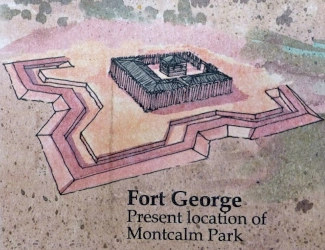
Fort George
The fort was built as an outer defense to Fort Oswego on the high ground of the southern bank of Lake Ontario, on the western side of the Oswego River prior to the battle of 1756. It was incomplete at the time of the battle. Meant to be a log stockade one hundred and seventy foot square with barracks, watchtower, and surrounded by earthworks.
Commanding the fort was Colonel Peter Schuyler with the Jersey Blues militia from New York, consisting of one hundred and fifty men. His superior, commander of both Fort Oswego and Fort George, was Lt. Colonel James Mercer. When it was attacked by the French with a land attack and bombardment from Fort Ontario on the eastern side of the Otsego River, the British surrendered the fort on August 14, 1756 to the French commander Marquis de Montcalm.
The fort was lost, destroyed, and never rebuilt. It's location is now within Montcalm Park, where there are two markers about the fort and battle.
Photo above: Photo of an interpretive marker for Fort George, site within Montcalm Park in western Oswego, New York, 2012, John Stanton. Courtesy fortwiki.com.

T-Shirts and Gifts from the official souvenirs of Americasbesthistory.com.
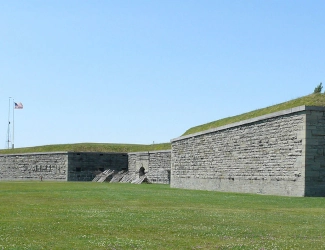
Fort Ontario
Fort Ontario was built in 1755 on the east bank of the mouth of the Oswego River and south bank of Lake Ontario. It had a spectacular view and post for the British to monitor French movements as the French and Indian War raged. It was originally known as the Fort of the Six Nations, but was insufficient in size to outlast an attack by French forces and Indian allies under the Marquis de Montcalm, eventually providing a launching pad against its stronger neighbor, Fort Oswego, for a land attack and bombardment. As stated before, all three forts were captured.
When the British returned, they rebuilt Fort Ontario. It was now a large earth and timber fort with a dry moat and outlying redoubts per 1759. For eighteen years, the British maintained Fort Ontario, but surprisingly abandoned it in the American Revolution during 1777, only to have the Continental Army from Fort Stanwix destroy it one year later. In 1782, the British came back and rebuilt the fort, retaining it until the Jay Treaty returned it to the United States in 1796.
Unfortunately, the American forces did little to maintain it, and during the War of 1812, in May of 1814, it, and the supply depot at Fort Oswego, were captured and destroyed by the British.
Once the War of 1812 ended, Fort Ontario was rebuilt as a garrison for one hundred and twenty troops by the United States in 1838 to protect against another invasion by the British from the north. It was improved during the Civil War, fearing British involvement on the Confederate side. Since that time, it has been subsequently abandoned by the Army, expanded to battalion size, and by 1941, included about one hundred and twenty-five buildings. During World War II, it housed victims from the Holocaust.
Photo above: The walls of Fort Ontario, 2009, Ad Meskens. Courtesy Wikipedia Commons C.C. 3.0.
About
America's Best History where we take a look at the timeline of American History and the historic sites and national parks that hold that history within their lands.
Photos courtesy of the Library of Congress, National Archives, National Park Service, americasbesthistory.com and its licensors.
- Contact Us
- About
- © 2022 Americasbesthistory.com.
Template by w3layouts.

